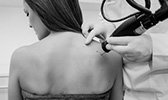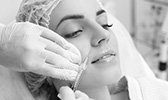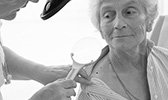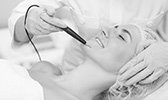The fellowship-trained Mohs surgeons at Braun Dermatology & Skin Cancer Center in Washington, DC and Alexandria, VA want you to be completely comfortable in deciding on Mohs surgery. In the below FAQs about Mohs, you will find helpful answers to common questions.

If you have been diagnosed with skin cancer, call us at
202-816-7557 to Learn More About Your Treatment Options.
What should I do the morning of Mohs surgery?
Unless otherwise instructed, eat your normal breakfast and take your usual medications.
Do I have to stop my blood thinners?
Unless otherwise instructed by your doctor, do not stop taking blood thinners.
What should I wear?
If the site is on your face, please come without makeup or earrings. Wear comfortable clothes and shoes. A button-down shirt is advised. In the event the shirt needs to be removed, it will not have to be pulled over the bandaged face. If the site is on the leg, wear loose pants that can be pulled up. If the site is on the back, wear a button-down shirt without an undershirt. If the site is on the hand or arm, do not wear jewelry such as rings or watches.
How should I get to and from the appointment?
If the surgical site is on your face, you should arrange for someone to drive you. This is due to concerns that swelling around the eyes may occur and could impede your visual field temporarily. We are also metro-accessible. Foggy Bottom metro is about six blocks away, and many patients find this option convenient. There is parking in the alley just before our building, for $23 a day.
Is it going to hurt?
Most patients are surprised at how little the whole process hurts. There is a small stick with a tiny needle to numb the area, and very minimal discomfort after initial numbing. Following surgery, if there is discomfort, it can generally be managed effectively with over-the-counter ibuprofen or acetaminophen. When appropriate, stronger pain medications are prescribed.
How long will the whole procedure take?
Plan on being with us the entire day. Most patients are finished within three to five hours. However, this is not guaranteed. Most of your time is spent in the waiting room while tissue samples area processed and analyzed. Many patients bring laptops, so they may work or watch movies; others bring a good book. There are many magazines in the office, as well.
How many stages will it take to remove my cancer?
On average, the procedure is completed in one to three stages, but there are cases where more are required. Please understand that many tumors have microscopic roots or extensions that must be meticulously tracked and removed with multiple stages.
Will I have stitches?
Some wounds require reconstruction or repair, while others are left open to heal. Each wound is unique and often the method of repair is not determined until the cancer is completely removed. Repair methods include a simple side-to-side closure, flaps, and grafts. Our team is well-trained in wound reconstruction, as well as Mohs surgery. Reconstruction is performed immediately after the Mohs procedure, on the same day.
Do I need to see a plastic surgeon?
In this practice, most Mohs surgery wounds are repaired by the Mohs surgeons. Reconstruction is part of our fellowship training. However, there are certain unique circumstances that do require involving ENT or plastic surgery colleagues. If you believe that you need or want a plastic surgeon to perform your repair and you are being referred to our office from another dermatologist, please inform our surgical coordinator. You will most likely need to schedule a consultation the plastic surgeon as well as our office, so that the services can be coordinated properly.
What should I do after the surgery?
After the surgery, please go home and rest. Specific instructions will be reviewed with you when the procedure is over. We typically recommend keeping ice on the area for 20 minutes every hour for the first day until you go to bed. It is important to elevate the area to reduce risk of swelling. To avoid bleeding or opening of the wound, we generally recommend no strenuous physical activity or lifting for seven to 14 days depending on the site. It is not advisable to travel far from the DC area for the first few days after surgery, so that you can return to our office if concerns arise.
What should I expect after the surgery?
Swelling, bruising, and minor bleeding are commonly seen after surgery. This improves dramatically over the first two weeks. Residual swelling is usually resolved in that time frame but can persist for months in a small subset of cases. Discomfort may occur initially and is best treated with rest, ice, elevation, and ibuprofen or acetaminophen. Prescription pain medications are occasionally needed and will be prescribed if appropriate.
What can I do to minimize scarring?
The best way to promote an optimal outcome is to follow post-operative wound care instructions and give the site time to heal. There is no way to remove cancer surgically without having a scar but faces often heal so well that it is difficult to see scarring. Scientific studies have shown that Mederma and Vitamin E are not effective in reducing scarring. There is a small amount of scientific support for topical silicone in scar reduction.
When do I follow-up?
Follow-up/suture removal visits are typically between one and two weeks. There may be additional follow-up visits depending on your situation. Once the area is healed, you will be advised to return to your referring physician for ongoing dermatological concerns and follow-up.
What is the cost of Mohs surgery?
Virtually all insurance companies consider Mohs surgery and repair a covered service. The cost varies as the number of stages and the method of repair is different for each patient. Additionally, as with all procedures, most insurance companies require the member to pay a certain amount out of pocket. Please contact our billing department to have a better idea of what your financial responsibility will be. If you are concerned about paying your portion of the medical bill, please discuss this with the billing department.
If I am concerned about how my wound is healing, what should I do?
Call us – 202-816-7557 in Washington, DC or 571-449-2555 in Alexandria, VA. There is always a provider on call.
How do I know if my wound is infected?
Wound infections are uncommon, but they can occur. A wound infection typically presents with increasing pain, redness, warmth, and sometimes a pus-type drainage. If a wound is infected, it must be evaluated by one of our providers, and antibiotics are typically prescribed. It is important to know that a certain degree of redness is normal as a wound heals. If redness is worsening, then it could be a sign of infection.



 Medical
Medical Cosmetic
Cosmetic Mohs
Mohs CoolSculpting
CoolSculpting Lasers and
Lasers and miraDRY
miraDRY